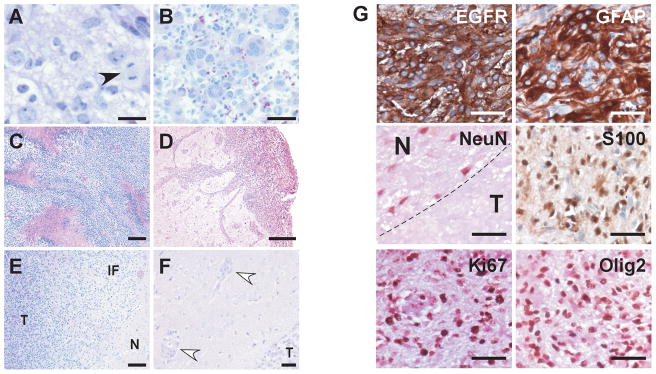Figure 2.
Representative histological photomicrographs of TGFα-EGFRWT;InkΔ2/3−/− tumors. H&E-stained paraffin-embedded tumor sections; A, Tumors are set on a fibrillary background and contain densely packed cells featuring pleimorphic nuclei with prominent nucleoli and mitoses (black arrowhead). B, Giant multinucleated cells are present within tumors. C, Tumors exhibit marked pseudopallisading necrosis. D–F, the highly infiltrative nature of TGFα-EGFRWT tumor cells is depicted, (D) tumor cells migrate within meninges in the subarachnoid space and invade the Virchow-Robin space and (E) are infiltrating normal parenchyma (N) by forming a loose infiltrating front (IF) away from the bulk tumor (T) and (F) tumor cells migrate along blood vessels and invade the perivascular space (white arrow head) distant from the bulk tumor (T). G, EGFRWT GBM tumors express markers of astrocytic differentiation. Representative photomicrographs of tumors stained with cell lineage markers using IHC. Tumors stain positive for markers of astrocytic lineage (glial fibrillary acidic protein (GFAP) and S100) and negative for markers of neuronal (NeuN) lineage. GBM tumors also stain positive for human EGFR, the proliferation marker Ki67, and for Olig2. EGFR, GFAP and S100 sections were counterstained with hematoxylin and sections for the nuclear NeuN, Olig2 and Ki67 markers were counterstained with eosin. N, normal brain; T, tumor. Scale bars; 25 μm (A), 50 μm (B,F,G), 62.5 μm (D), 125 μm (C, E).

